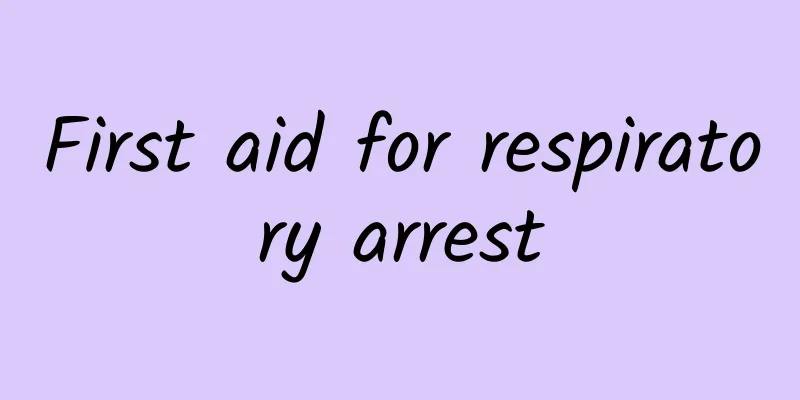First aid for respiratory arrest

|
Humans rely on breathing to maintain the normal physiological functions of the body. If a person stops breathing, it means that the person has lost his life, but there is still a certain chance of rescue within a few minutes of breathing cessation. When a person stops breathing, the people around him must implement correct first aid measures on him, so that there is hope of pulling this person back from the brink of death. Therefore, it is very necessary to learn first aid measures for respiratory arrest. What to do if breathing stops If the patient's airway is clear, the rescuer puts his ear close to the patient's mouth and nose to listen for the sound of airflow through the patient's airway, or The practitioner puts his face close to the patient's mouth and nose to feel whether there is any gas exhaled. At the same time, observe whether the patient's chest rises or falls. If there is no spontaneous breathing, give artificial respiration immediately. If the patient's jaws are clenched and mouth-to-mouth artificial respiration cannot be performed, mouth-to-nose breathing can be used. Blowing method and mouth-to-mouth blowing method The same. Just pinch your lips instead of your nose and blow air into your nostrils. First aid for respiratory arrest 1. Quickly undress and clear out the contents of the mouth. If the tongue falls back, use forceps to pull it out. 2. The patient needs to lie in supine position with the head tilted back as far as possible. 3. Perform mouth-to-mouth artificial respiration immediately. The method is: the patient lies on his back, and the nurse lifts the patient's lower jaw with one hand to tilt his head back to relieve the airway obstruction caused by the dropped tongue and keep the airway open; with the other hand, pinch the patient's nostrils to prevent gas from escaping from the nose when blowing. The nurse then takes a deep breath and blows hard into the patient's mouth until the chest swells slightly. Afterwards, the nurse turns the head slightly to the side and immediately relaxes the hands that are pinching the nostrils, allowing the patient to breathe on his own, and repeats this process. An adult inhales 12-16 times per minute, and the exhalation time should be short, accounting for about one-third of one breathing time. If there is no response to blowing, you need to check whether the airway is open and whether the blowing is appropriate. If the patient's teeth are clenched, the caregiver can blow air from mouth to nose instead. The method is basically the same as mouth-to-mouth artificial respiration. First aid measures for cardiac arrest First, let the patient lie on a hard bed or flat ground, unbutton his shirt, and the rescuer places the palm of one hand on the lower third of his sternum, and the other hand overlaps and presses on the back of his hand. The rescuer keeps his arms vertical and presses downward continuously with the weight of his upper body at a frequency of about 70 times per minute. When pressing, use moderate force, so that the sternum sinks 3 to 5 cm each time. Be careful not to remove your palm from the pressing area at any time. First aid measures for cardiac and respiratory arrest After breathing and heartbeat stop, the brain will quickly become deprived of oxygen, and half of the brain cells will be damaged within 4 minutes. If CPR is performed more than 5 minutes later, only 1 in 4 people can be saved. When performing cardiopulmonary resuscitation, first use your fist to rhythmically and forcefully tap the heart area on the inside of the patient's left nipple on the chest 2 to 3 times. When raising the fist, keep it 20 to 30 cm away from the chest to control the force of the tapping. If the pulse has not recovered, immediately perform four consecutive mouth-to-mouth artificial respirations, followed by chest compressions. When one person performs cardiopulmonary resuscitation, they should perform artificial respiration after every 15 heart compressions. When two people work together to perform cardiopulmonary resuscitation, they first perform artificial respiration four times in a row. Then, one person performs five consecutive heart compressions and stops while the other person performs one artificial respiration. |
<<: How long is the Hepatitis C window period?
>>: How big is the fetus at 16 weeks of pregnancy
Recommend
Calcification of the anterior longitudinal ligament
The anterior longitudinal ligament is the ligamen...
What is the six-item hormone test?
Many people may not pay much attention to or unde...
How to treat blood heat fastest
Blood heat is a term in traditional Chinese medic...
What to do if you keep burping
I believe many people have experienced burping. I...
What are the effects and functions of golden cherry
Laevigata chinensis is a common Chinese patent me...
How to quickly relieve toothache
When we were young, we had tooth decay. One reaso...
More than 10 Chinese herbal prescriptions for strengthening the spleen and removing dampness
As for the spleen, it is responsible for transpor...
Do you know how to treat anterior vaginal wall prolapse?
The vagina is the most important reproductive org...
What causes Trichocystis?
Demodex is usually caused by inadequate skin clea...
Drugs for treating polycystic kidney disease
When people have kidney problems, it will bring m...
Can I eat durian while taking Chinese medicine? Are there any taboos?
There are many dietary taboos while taking Chines...
Lung sarcoma, the two most common types
Sarcoma can occur in any part of our body, and th...
What causes nose bleeding when washing face?
I believe everyone is familiar with nosebleeds. T...
Blood clot in the brain
There is congestion in the brain, also known as c...
What is the effect of moxibustion on weight loss?
Moxibustion is indeed very effective in losing we...









